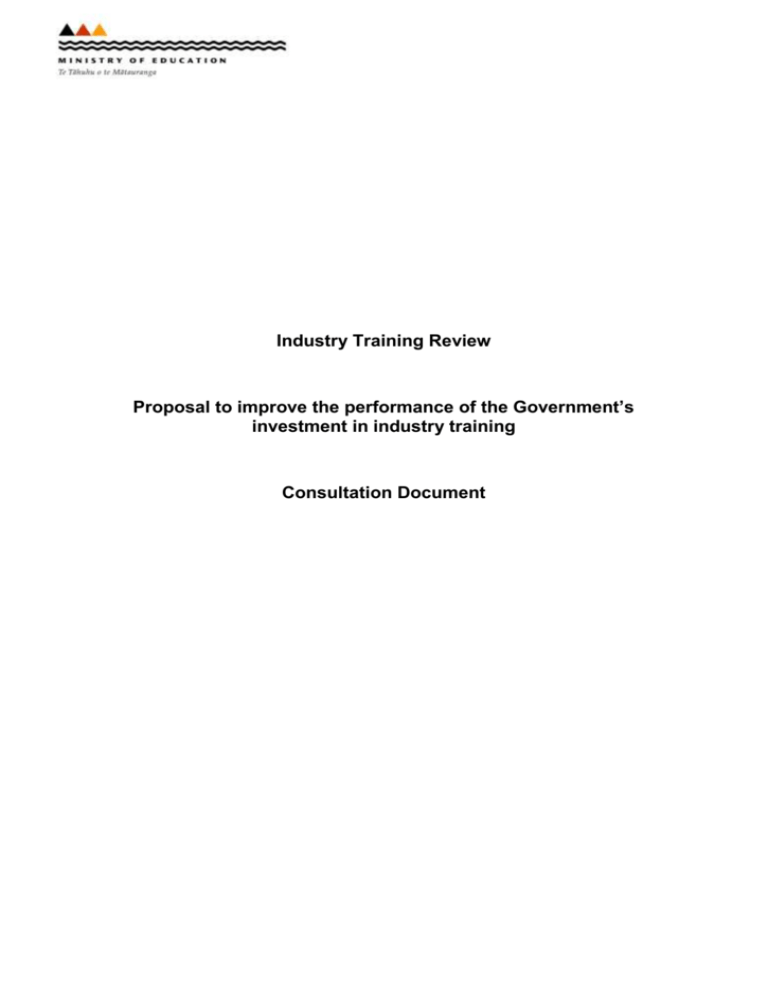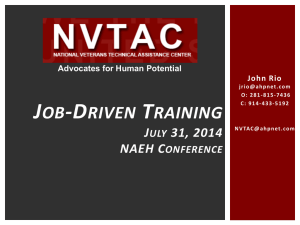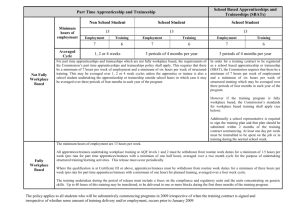What is industry training?
advertisement

Industry Training Review Proposal to improve the performance of the Government’s investment in industry training Consultation Document Executive summary This consultation document seeks views on a proposal to make changes to the policy settings for industry training following a review that commenced in 2011. It is intended that the changes will create an environment that will better support trainee achievement and progression through vocational education and training, by ensuring that employers and trainees are well served by industry training organisations (ITOs) with appropriate incentives. The proposal was considered within the context of the wider vocational education and training settings, and needs to be considered alongside ongoing operational policy changes. The key proposed changes to industry training policy that the Ministry of Education are seeking feedback on are as follows: ITOs will focus on two key functions – arranging training and skill setting for industry. Greater simplicity, accountability and clarity of the ITOs’ functions and roles. Higher expectations for qualification completions and programme completions for ITOs. Industry will have responsibility for communicating skill needs directly to Government to create closer links between education, employment and industry. Amalgamating all apprenticeships into the Modern Apprenticeships scheme, making the same level of support available for all apprentices, regardless of age. Raising the current 10% restriction on industry training at levels 5 and 6. Either the Modern Apprenticeship co-ordination fee should be incorporated into the Modern Apprenticeship training rate or kept as a separate rate. Adjust to a more sustainable funding regime that increases the subsidy rate for traineeships (programmes of 40 credits or greater) and introduces a new, higher subsidy rate for apprenticeships (currently Modern Apprenticeships are 100 credits or greater). A higher rate per trainee is being considered as part of the expectations for improved performance. Remove disincentives for allowing trainees to progress into employment and apprenticeships from a provider, and for transferring into a provider to complete a qualification if their employment situation changes. Review quality assurance mechanisms to include management of the processes for assuring consistency of graduate outcomes as a role of the qualification developer. Review quality assurance systems for unit standards, with the view that, over time, new versions will be flexible enough to be able to be delivered in a range of delivery settings. The proposal focusses on changes to the policy for industry training. It is anticipated legislative changes to the Industry Training Act 1992 and integrating aspects of the Modern Apprenticeship Training Act 2000 will be needed to implement changes from 2014. Any operational changes will be implemented progressively over 2013 and 2014. A working party of sector and industry representatives, as well as government officials, will work through the implementation issues once final policy decisions have been made. Feedback can be submitted to tertiary.strategy@minedu.govt.nz. The deadline for providing feedback is 12 September 2012. 2 Introduction Purpose of this document This consultation document seeks views on a proposal to change New Zealand’s industry training system to improve its effectiveness for employers, trainees and the Government. The proposal aims to address the problems identified through the review of industry training while meeting the training needs of employers and employees, improving the clarity of training pathways, and delivering better value for Government’s investment. The proposal will be refined following the consultation process. We would like to hear your views on the benefits and risks of this proposal for employers and trainees in your industry. How to provide feedback You can provide feedback by emailing: tertiary.strategy@minedu.govt.nz. The deadline for providing feedback is Wednesday, 12 September 2012. We are happy to receive feedback in an email, or you could use the feedback form at the end of this document. Process from here The Minister for Tertiary Education, Skills and Employment will consider feedback on this proposal when making final decisions on changes to industry training. The Minister expects to announce final decisions in November this year with the view that the new policy settings will come into effect progressively during 2013 and 2014. This proposal will require changes to the Industry Training Act 1992. It will also involve integrating aspects of the Modern Apprenticeship Training Act 2000 into new industry training legislation. A working party, comprising sector and industry representatives as well as government officials, will work through the implementation issues once final policy decisions have been made. 3 Background to the proposal What is industry training? Industry training is systematic work-based training that leads to national qualifications. New Zealand’s industry training system encompasses initial vocational training (apprenticeships), foundation education, and continuing vocational education for employees. Most industry training funding is for qualifications at levels 1 to 4 on the New Zealand Qualifications Framework (NZQF). Government funding is focussed on the lower end of the qualifications framework to incentivise employers to invest in training lower-skilled employees towards full qualifications. Lower-skilled employees generally attract less investment from employers than higher-skilled employees. Industry training organisations (ITOs) are industry-owned bodies that support industry training in New Zealand. ITOs currently have three main roles under the Industry Training Act 1992: setting skills standards for their industries, arranging training towards those skill standards, and providing leadership within their industries on matters relating to skills and training. The Modern Apprenticeships scheme provides additional support to young people in long industry training programmes at levels 3 and 4 of the NZQF. The additional support is provided by Modern Apprenticeships Co-ordinators (MACs), who may be an ITO, a tertiary provider, a group training scheme or an independent organisation. There are currently 31 ITOs across a range of industries. In 2011, there were approximately 148,000 trainees enrolled. Why does Government invest in industry training? Government subsidises industry training to encourage employers to invest in training to upskill employees with broad and transferable skills that result in industry-recognised qualifications. It is not intended as a straight subsidy for employers towards business-asusual activities. Government’s investment in industry training is substantial – the 2012/13 baseline for industry training (including Modern Apprenticeships) is $207.4 million. Industry training is cofunded with industry: Government provides approximately 70% of the cash cost of training, while employers are expected to fund 30%. This recognises that industry training benefits the employer as well as the individual and the wider economy. Why is Government reviewing industry training? New Zealand’s industry training system was reformed in 1991. It has been nearly 20 years since the Industry Training Act 1992 was enacted, and 10 years since it was revised and the Modern Apprenticeship Training Act 2000 enacted. Compared to the previous apprenticeship system, the flexibility of industry training has proven successful in responding to different employer needs and engaging new industries. Structured industry training has been extended to many new industries and to individuals who have not successfully undertaken education in the past. 4 However, there have been concerns about the performance of industry training. Less than a third of trainees achieve a qualification five years after starting their industry training programme. Between 2000 and 2010, an average of 53% of industry trainees and 36% of modern apprentices achieved no credits even though they attracted a government subsidy. In 2009, half of the credits trainees were enrolled in were achieved. Beginning in 2010, the Tertiary Education Commission (TEC) has undertaken a series of compliance reviews of ITOs. These reviews identified that some ITOs were claiming funding for ineligible trainees, including where there was no evidence of employment or that a valid training agreement was in place. This has resulted in the TEC recovering $4.3 million in funding from ITOs. In response to performance issues and evidence of low-value provision, the TEC also made a number of changes to operational policy settings. These changes include only funding trainees who are appropriately progressing through their programmes and requiring evidence of credit achievement. The recent compliance and operational policy reviews have addressed some important aspects of performance and the effective use of public funds, and performance of the ITO sector has significantly improved, as figure one below shows. In 2010, following the TEC’s operational changes, programme completions have increased to 65% and preliminary 2011 data indicates they have reached 70%. A number of other policy changes were also agreed during 2010 to improve the link between funding and performance, and to focus funding upon training with wider economic benefits. The changes included the introduction of performance-linked funding; placing greater emphasis on the rate of industry cash contribution for the purposes of recognising organisations as ITOs; requiring literacy and numeracy as part of all level 1 and 2 training; and removing funding for training primarily designed to fulfil regulatory compliance or health and safety requirements. In parallel with the TEC’s operational changes, the Minister asked for a wider policy review to be undertaken to ensure that the policy principles of industry training support further improvement of ITO performance, and are conducive to a better-performing vocational education and training sector generally. 5 Figure 1: Participation and performance of industry trainees, 2006 – 2011 250,000 80 200,000 60 50 150,000 40 100,000 Percentage Number of trainees/Modern apprentices 70 30 20 50,000 10 0 0 2006 2007 2008 2009 2010 2011* Industry trainees (LH axis) Modern Apprentices (LH axis) Credit weighted programme completion rate (%) (RH axis) Credit achivement rate (%) (RH axis) * 2011 results are preliminary. Process of the review The Ministry of Education commenced a policy review of industry training in 2011 to assess whether the current model is still fit-for-purpose. The Ministry looked at the history of industry training, made international comparisons, consulted on a discussion paper of industry training systems, and used interviews and surveys to gather feedback. Six papers produced during the course of the review can be found at www.minedu.govt.nz using the quicklink on the right-hand side of the homepage. Findings of the industry training review The key themes that emerged through the review were: ITOs vary in terms of the level of service they provide to employers and trainees, their performance, and their connection with industry. The industry training funding rate does not adequately support the level of theory learning required in traditional apprenticeships (qualifications of 200 credits or greater at NZQF levels 3 and 4 that provide entry into an occupation or trade). Tensions between ITOs and tertiary providers have contributed to the proliferation of qualifications and hindered easy transitions between sectors for learners. The Modern Apprenticeships scheme, which provides additional support to young people in specific industry training programmes, lacks accountability. Transferring to a different part of the tertiary sector part-way through a qualification, for example, changing from a polytechnic programme to employment and an apprenticeship, can be difficult, and vice versa. 6 Proposal for consultation While this proposal is focussed on industry training, the review has been conscious of the impacts that changes to industry training will have upon the wider vocational education and training sector. You are welcome to provide feedback on all aspects of the proposal. The table on page 11 provides the elements of the proposal, how it changes from the status quo, rationale for each element and feedback questions for consideration. Summary of proposal ITO functions and role 1. The first key focus for ITOs is to provide excellent support and service to employers and trainees, resulting in the successful achievement of qualifications. 2. The second key focus for ITOs is to undertake the standard-setting function for their respective industries. 3. The Government would have higher expectations of qualification and programme completions for ITOs. 4. Industry will have responsibility for communicating skill needs directly to Government, with support by the Ministry of Business, Innovation and Employment (MBIE) and the TEC, to create closer links to education, employment and industry. 5. A more sustainable funding regime would be put in place that increases the subsidy rate for traineeships and introduces a new, higher subsidy rate for apprenticeships. A higher rate per trainee is being considered as part of the expectations for improved performance. 6. All apprenticeships will be amalgamated into the Modern Apprenticeships scheme, making the same level of support available to all apprentices regardless of age. The definition of an apprenticeship will be clarified. 7. Feedback is sought on whether the Modern Apprenticeships coordination fee should be incorporated into the training rate for apprentices, or whether it should be kept as a separate fee. 8. The current 10% restriction on training at levels 5 and 6 will be raised. Transferability across tertiary sectors 9. To encourage greater transferability of learning between ITOs and providers, the TEC will remove disincentives from transferring between industry training and provider courses by recognising continuation of a qualification across sub-sectors as a positive outcome. 7 Quality assurance 10. Feedback is sought on how moderation and consistency of graduate outcomes should be managed and funded in future. Possible options are: for external moderation, only applying to standards relating to skills critical to an occupation as identified by industry removing the credit rebate for external moderation and funding the qualification developer to manage consistency of graduate outcomes using this funding introducing a small levy to enable the qualification developer to manage consistency of graduate outcomes. 11. The NZQA intends to review its rules and guidelines for setting unit standards. Over-time, as unit standards are redeveloped, new versions will be flexible enough to be contextualised to a range of settings rather than developing new standards for each setting. NZQA will be consulting later in the year on rules for recognition of prior learning. What will the proposal mean for employers, trainees and industry? Employers Employers should see a more consistent level of service and support from ITOs. Employers should expect a greater degree of mentoring to assist in training employees, more support for trainees and apprentices to keep them on track, and a greater level of assessment services being provided by ITOs or organisations contracted by ITOs. ITOs will be expected to communicate with employers more clearly and in a timely manner about progress of trainees and apprentices towards qualifications. The consolidation of the ITO sector should reduce the compliance costs for employers currently dealing with multiple ITOs and reduce duplication of effort. Employers will be expected to support trainees and apprentices towards completion of qualifications. Trainees and apprentices Trainees and apprentices should see a higher level of support for their learning from ITOs or organisations contracted by ITOs. Trainees and apprentices who need a higher level of assistance should see a higher level of contact and pastoral care. A higher subsidy for apprenticeships is anticipated to result in higher quality theory and offjob learning for apprentices. Students should see better pathways to transfer between ITOs and tertiary providers, and vice versa. Industry Industry groups will have a clearer and more direct way to communicate their skill needs to Government and to influence government funding of tertiary education. 8 Industry should see a greater return on its investment in industry training, as a greater proportion of trainees will be upgrading their skills. The proposal is likely to result in fewer enrolled trainees than would have been the case under the old settings, but many more of these trainees will be earning credits and completing qualifications. It is anticipated that there will be a greater proportion of younger trainees overall in industry training, because young people are more likely to complete full qualifications. Industry should see larger and more competent ITOs developing fit-for-purpose standards and qualifications. 9 Outline of the proposal Proposal Status quo Detail on the proposal Rationale for proposal 1. ITOs focus on providing excellent service and support to employers and trainees. ITOs arrange training and are prohibited from delivering training. The boundary between arranging and delivery is blurred. ITOs will continue to support training in the workplace through: ITOs will be able to undertake the activities employers most value – providing support for on-job training. ITOs vary in the type and level of support they provide to employers and trainees. developing learning materials training and mentoring workplace trainers supporting the learning of trainees providing assessment services contracting tertiary providers to deliver the theory, or off-job, learning. Clarifying expectations about the level of support provides transparency for employers and addresses variability in ITO support for training. Through the investment plan guidance, government will set clear expectations around the support employers and trainees should expect from ITOs. ITOs will be able to focus on support for on-job training and explore innovative ways of meeting industry demand for training. ITOs will be expected to assist in planning how a qualification can be achieved within a company to assess learner needs to ensure they are enrolled in an appropriate programme with the right kind of support, and to provide timely and regular feedback to employers and trainees on their progress through programmes. Clearly articulating what constitutes arranging training removes uncertainty about the boundary between arranging and delivery of training. Feedback question: In your view, what are the benefits and risks for employers and trainees in your industry of retaining the arranging training role of ITOs and clarifying expectations of service to employers and trainees? 10 Proposal Status quo Detail on the proposal Rationale for proposal 2. ITOs focus on the standard-setting function for their respective industries. ITOs collaborate with industry on the development of skill standards. ITOs will continue to collaborate with industry on the development of skill standards and qualifications. Many standards are very small and relate to discrete tasks rather than skills. Industry skill standards are a public good. ITOs will no longer be able to require other organisations to adopt their learning and assessment materials. Significant change to the standard-setting function has not been proposed as feedback noted that employers highly valued it. Some ITOs require that other organisations adapt their learning and assessment material if they offer the ITOdeveloped standard, which disincentivises the adoption of common standards across the tertiary sector. The qualification development process remains the same as it is now, including the implementation of the Targeted Review of Qualifications. Allowing tertiary providers and other ITOs to contextualise learning and assessment for their delivery settings removes a barrier to the adoption of common standards across the vocational education system. This will help learners to transition between sectors. ITOs set standards both through the individual standards and through qualification development of National Certificates. Feedback question: In your view, what are the benefits and risks for employers and trainees in your industry of retaining ITOs’ standard-setting function and allowing tertiary providers and other ITOs to use ITO-developed standards more freely? 11 Proposal Status quo Detail on the proposal Rationale for proposal 3. Higher expectations of qualification and programme completions for ITOs. Current performance expectations for ITOs are reasonably low – the only expectation in the investment plans with clear consequences is that each trainee is expected to achieve at least one credit per year. ITOs are also subject to potential loss of up to 5% of government funding through performance-linked funding. The Government would expect higher qualification and programme completion rates in industry training. The TEC would shift funding over time away from programmes with very low completion rates. There would also be higher expectations of progression from level 2 qualifications to levels 3 and 4 qualifications, which provide greater career benefits to trainees. Higher expectations of qualification completions will be needed to meet the Better Public Services target of 55% of 25to 34-year-olds having a qualification at level 4 or above in 2017. Feedback question: What are the benefits and risks for employers and trainees in your industry of increasing the expectations for ITOs of qualification and programme completions? 12 Proposal Status quo Detail on the proposal Rationale for proposal 4. Industry will be responsible for communicating skill needs to Government, with support from MBIE and the TEC. ITOs have a skills leadership role in the Industry Training Act 1992, but it is not clearly defined. The statutory skills leadership role would be removed. Industry groups would work directly with MBIE and the TEC to communicate industry’s skill needs. Remove duplication of effort between ITOs and industry groups relating to skills planning. ITOs will still be able to contribute to skills leadership by industries, alongside other stakeholders. Focus ITOs on the roles that industry values most – standard setting and arranging training. Industry groups will communicate more directly with government agencies about their training and skill needs. Feedback question: What are the benefits and risks for employers and trainees in your industry of transferring the skills leadership function to industry? 13 Proposal Status quo Detail on the proposal Rationale for proposal 5. A more sustainable funding regime that increases the subsidy rate for traineeships and introduces a new, higher subsidy rate for apprenticeships. ITOs are funded according to how many trainees they arrange training for and the size and length of the training programmes those trainees are undertaking. ITOs have flexibility on how they use their funding across their roles. The standard training measures rate for 2012 is $2,919 with a maximum of $1,702 able to be claimed for the maximum 70 credits to be achieved per year. It is proposed that there will be two funding rates for industry training – a lower rate for traineeships (programmes of 40 credits or greater at NZQF levels 1 to 4) and a higher rate for apprenticeships (currently Modern Apprenticeships are 100 credits or greater). Provide a sustainable funding regime. In the past, some ITOs have relied on both active and inactive trainees to sustain their operations. This is no longer possible. Note, proposal 7 requests feedback on whether the MAC fee should be built into the apprenticeship training rate. ITOs are invited to provide costings for training to inform modelling of changes to the funding rate. Provide a higher subsidy for apprenticeships to recognise the higher level of theory learning required as part of these programmes, and incentivise greater uptake of apprenticeships, which has the highest rate of return for trainees, employers and Government. Any funding changes will be met from within baselines and incorporated into Budget 2013. The principle of co-funding by industry will continue and employers will be expected to contribute 30% of the cash cost of training. Feedback question: What are the benefits and risks for employers and trainees in your industry of introducing a higher subsidy rate for apprenticeship training? 14 Proposal Status quo Detail on the proposal Rationale for proposal 6. Amalgamating all apprenticeships into the Modern Apprenticeships scheme, making the same level of support available for all apprentices, regardless of age. Apprenticeships are currently differentiated between Modern Apprenticeships for those aged 16 to 21 and others undertaking apprenticeship programmes. Apprenticeship support would be extended to all apprentices regardless of age. Those undertaking apprenticeship programmes should receive adequate support and service, regardless of age. Modern Apprenticeships are currently qualifications of 100 credits or more, at NZQF levels 3 or 4. The definition of an apprenticeship, including credit values and duration, will be clarified. Apprenticeships would still be targeted to young people, but not mandated. Industry training can be an effective way of engaging in education, particularly for those who have not been in employment, education or training, of which a significant proportion are aged 20 to 24 years. A standard definition of an apprenticeship will provide greater clarity to ITOs and employers. Feedback question: What are the benefits and risks for employers and trainees in your industry of extending apprenticeship support to all apprentices, regardless of age? 15 Proposal Status quo Detail on the proposal Rationale for proposal 7. Either incorporate the MAC fee into the training rate for apprentices, or keep it as a separate fee. MACs receive a fee for every learner who qualifies for the Modern Apprenticeships scheme. The fee does not vary according to the size of the programme the modern apprentice is undertaking. Two options are proposed for feedback: Combining the co-ordination fee simplifies funding for apprenticeships. ITOs, tertiary providers, and independent organisations can be MACs. ITO MACs receive $1,777 (GST excl) per modern apprentice, while non-ITO MACs receive $1,956 (GST excl) per modern apprentice. MACs visit modern apprentices four times a year, they provide advice to employers and modern apprentices, and may work with schools to transition students into apprenticeships. MACs are not accountable for modern apprentice qualification completions. 1. the co-ordination fee is incorporated into the apprenticeship rate 2. the co-ordination fee is not incorporated into the apprenticeship rate, and ITOs are given responsibility for managing apprenticeship coordination contracts. Both options shift responsibility to ITOs, which are the organisations responsible for qualification completions. If apprenticeship support remains separate, payments may be staggered according to recruitment, retention and completion. The funding baseline will remain the same. Feedback question: Which of these two options is more likely to result in better service to employers and apprentices and why? 16 Proposal Status quo Detail on the proposal Rationale for proposal 8. Raising the current 10% restriction on training at levels 5 and 6. ITOs have a cap of 10% of their total allocation for arranging training above level 4. The 10% cap will be raised to 15% to 20% for training at levels 5 and 6. Industry training can be an effective and efficient way to deliver higher levels of training. Supporting higher levels of training through industry training will likely contribute to increases in productivity and greater returns for both the firm and the learner. Increasing the amount of high-level industry training will contribute to the Government’s Better Public Services target to increase the number of 25- to 34year-olds with a level 4 qualification or greater. Feedback question: What are the benefits and risks for employers and trainees in your industry of allowing a greater volume of industry training at levels 5 and 6? 17 Proposal Status quo Detail on the proposal Rationale for proposal 9. Remove disincentives to transferring between industry training and provider courses by recognising continuation of a qualification across sub-sectors as a positive outcome. Providers are measured on four educational performance indicators (EPIs) – retention, progression, course completions and qualification completions. ITOs are measured on credit achievement and programme completions (respectively). For providers, employment and progression into an apprenticeship will not be treated punitively. Only course completions will be measured for those learners. Employment and progression into an apprenticeship will not count as an unsuccessful qualification completion. Employment or continuation of education is a positive outcome. The EPIs are per institution and do not recognise successful outcomes if learners transfer between sub-sectors (i.e. a polytechnic student progresses to employment and apprenticeship, or an employee loses their job and wants to complete their qualification at a provider). For ITOs, credit achievements will be measured for trainees who may leave employment but re-engage in education through a provider. This will not count as an unsuccessful programme completion. Feedback question: What are the benefits and risks of this approach for learners who transfer between tertiary sectors? 18 Proposal Status quo Detail on the proposal Rationale for proposal 10. Lead qualification developers will manage the process for assuring the consistency of graduate outcomes. ITOs and tertiary providers internally moderate their own assessments. Qualification developers will manage the process for assuring the consistency of graduate outcomes across those qualifications they have developed. A mechanism is needed to provide assurance that the outcomes achieved by graduates awarded a New Zealand qualification meet the graduate profile and are comparable, regardless of the programme undertaken. This will give confidence to learners, employers and industry in the qualification and the programmes leading to it. ITOs externally moderate the assessment of standards that are offered by tertiary providers and by other ITOs. They receive a credit rebate to enable them to do this. Qualifications are developed in a collaborative way with a designated qualification developer. The qualification developer is responsible for co-ordinating the process to manage consistency of the outcomes of their qualifications. NZQA is responsible for addressing concerns about tertiary providers’ performance. Managing consistency is not currently funded. We are seeking feedback on how external moderation and managing consistency of graduate outcomes should be conducted and funded in the future. Possible options are: 1. Applying external moderation only to standards relating to skills critical to an occupation as identified by industry (e.g. welding within an engineering apprenticeship). The credit rebate would only apply to these standards. 2. Removing the credit rebate for external moderation, with some of this funding used to enable qualification developers to manage consistency of graduate outcomes. 3. Introducing a small levy to enable the qualification developer to manage consistency of graduate outcomes. External moderation of assessment is important for the core technical skills within a qualification. Industry needs assurance that assessments are fair and valid and that learners with these standards are consistently competent. Feedback question: How should external moderation and managing consistency of graduate outcomes be conducted and funded to ensure learners are consistently competent while minimising compliance costs and enhancing collaboration across tertiary sectors? 19 Proposal Status quo Detail on the proposal Rationale for proposal 11. Review of unitstandard qualityassurance settings will be undertaken with the view that unit standards will be flexible and able to be contextualised to different settings. There is currently a large number of unit standards on the New Zealand Qualifications Framework, some of which cover the same skills but are specific to certain settings (e.g. they have to be delivered in a work environment). NZQA will review its requirements for unit standards with the view that, over time, as unit standards are redeveloped, unit standards will be robust and flexible, and be able to be assessed in a range of different settings. To incentivise the adoption of unit standards, and implicitly, a common currency for vocational education and training that spans both the secondary and tertiary sectors. Government expects industry skill standards to be more clearly focused on learning outcomes. Unit standards will be more fit-for-purpose and able to be contextualised to a range of settings. Some unit standards reflect transferable skills that are individualised to particular settings, causing a high level of duplication and proliferation of unit standards. Industry skill standards are a public good. ITOs will no longer be able to require other organisations to adopt their learning and assessment materials. Duplication and proliferation of unit standards will reduce, creating a simpler standards system, and greater clarification for learners and employers. A common currency of skill recognition will assist in recognition of prior learning and of school-to-tertiary transitions (particularly the Vocational Pathways), and can be recorded in a single place (the Record of Achievement). Feedback questions: Will the proposal incentivise greater uptake of unit standards in providers? What other issues disincentivise the adoption of unit standards? Do you agree that vocational education and training should have a common currency for learning and skills? 20 Feedback form Please email your feedback to tertiary.strategy@minedu.govt.nz by Wednesday, 12 September 2012. Please take as much space as you need to provide your feedback. The questions are a guideline only – please feel free to comment on any aspect of the proposal. 1. In your view, what are the benefits and risks for employers and trainees in your industry of retaining the arranging training role of ITOs and clarifying expectations of service to employers and trainees? 2. In your view, what are the benefits and risks for employers and trainees in your industry of retaining ITOs’ standard-setting function and allowing tertiary providers and other ITOs to use ITO-developed standards more freely? 3. What are the benefits and risks for employers and trainees in your industry of increasing the expectations for ITOs of qualification and programme completions? 4. What are the benefits and risks for employers and trainees in your industry of transferring the skills leadership function to industry? 5. What are the benefits and risks for employers and trainees in your industry of introducing a higher subsidy rate for apprenticeship training? 6. What are the benefits and risks for employers and trainees in your industry of extending apprenticeship support to all apprentices, regardless of age? 7. Which of these two options for the apprenticeship co-ordination fee is more likely to result in better service to employers and apprentices and why? 8. What are the benefits and risks for employers and trainees in your industry of allowing a greater volume of industry training at levels 5 and 6? 9. What are the benefits and risks of recognising completions for learners who transfer between tertiary sectors? 21 10. How should external moderation and managing consistency of graduate outcomes be conducted and funded to ensure learners are consistently competent while minimising compliance costs and enhancing collaboration across tertiary sectors? 11. Will NZQA reviewing its quality assurance settings for unit standards incentivise greater uptake of unit standards in providers? What other issues disincentivise the adoption of unit standards? Do you agree that vocational education and training should have a common currency for learning and skills? 22




